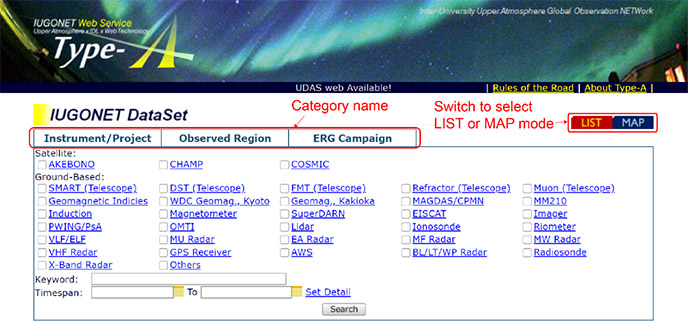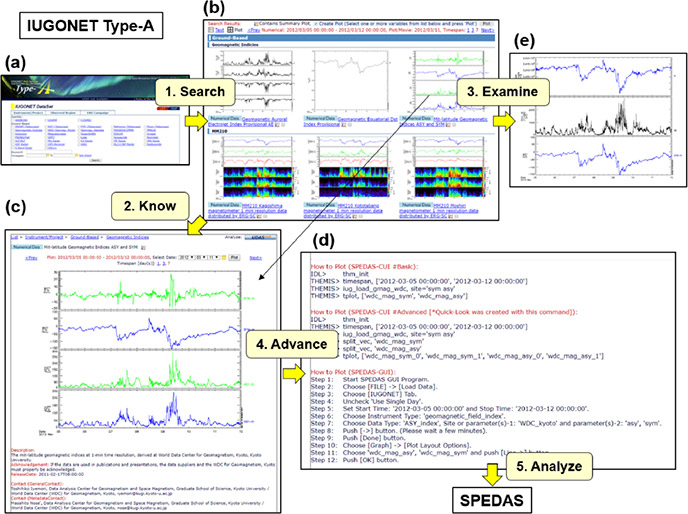National Institute of Polar Research
Japan sets up online portal for ‘space weather’ researchers and educators
April 17, 2023
Phenomena in the upper atmosphere, including the impacts of ‘space weather’ from the sun, is of crucial importance with respect to risks to space exploration, telecommunications and much of our technology-based modern world, yet this region at the edge of space is poorly understood. Making matters worse, relevant data have been widely dispersed, and until recently, appropriate software tools have not been integrated with these sources of information.
An alliance of Japanese universities has taken over a decade to fix this disaggregation and software problem, and developed a one-stop-shop web portal for researchers and educators focused on such solar-terrestrial physics.
They described their project and its functionality in a paper appearing in the Geoscience Data Journal published on June 23, 2022.

Figure1: Top page of the metadata database IUGONET Type-A (http://search.iugon et.org).
Earth's upper atmosphere, which stretches from 50 to 500 km above the planet’s surface, and involves multiple layers—the mesosphere, thermosphere and ionosphere (the ionized part of the atmosphere), experiences a range of overlapping physical and chemical phenomena that are not only poorly understood, but also often just very difficult to understand.
Conditions in the upper atmosphere are generated by complex interactions between ‘space weather’—solar radiation (and conditions on the sun), solar wind and particle ‘precipitation’ from the magnetosphere (the area in space controlled by the Earth’s magnetic field)—and events in the lower atmosphere.
Investigators exploring such electromagnetic, photochemical and other interactions between Earth and Sun in this vast region call their field solar-terrestrial physics (or STP). Their findings are of crucial importance to multiple high-value endeavors, from space exploration (relating to impacts on orbital calculations, vehicle re-entry and space debris lifetime) to telecommunications and technological society more broadly (as a result of risks from geomagnetically produced currents or particle bombardment of satellites).
Given the central role the upper atmosphere plays in the maintenance of much the modern world depends upon, it may be surprising that we still know very little about its various phenomena.
“We currently have very limited ability to predict the long-term variation of this region,” said Yoshimasa Tanaka, one of the portal’s developers and a researcher with the Polar Environment Data Science Center at Japan’s Research Organization of Information and Systems. “It’s sort of like going to sea in a boat without maps or any knowledge of what the weather may be like.”
Making the challenge that much harder, data sets used in upper-atmosphere research are obtained using many different types of measurement instruments, covering a great many different physical phenomena (such as plasma, gases, and electric and magnetic fields), from many regions (solar surface, interplanetary space, the atmospheres multiple layers, and the ground itself), many locations on earth (from the poles to the equator), and from a great many different institutions and missions. Until recently, none of this was integrated into a single resource.
Atop this, some solar-terrestrial phenomena require long-term monitoring in order to understand and predict them. A single solar cycle is about 11 years long. Thus data from a time span longer than 11 years are needed to investigate the dependence of upper-atmospheric conditions on the solar cycle. The good news is that, for example, geomagnetic field data from a French observatory goes back as far as 1883; the bad news for data management is that much of this is in analog format.
So in 2009, a group of Japanese institutions took it upon themselves to bring some order to the chaos, and established the Inter-university Upper atmosphere Global Observation NETwork (IUGONET). IUGONET has developed a number of data analysis products, from software (based on Space Physics Environment Data Analysis Software, or SPEDAS) to a metadata database to assist STP researchers.
A web-based offering with a very basic user interface was launched the following year. This first iteration of the data service proved very useful for researchers in terms of being able to finally locate various data sets, but it still did not offer any integrated tools to actually conduct research. It was difficult for researchers to move from identifying a data set to performing data analysis using only the metadata catalog. In addition, there was no connection between the SPEDAS-based software and the data service.
A second iteration of the data service, IUGONET Type-A, was launched in October 2016 that delivered a number of improvements on the first. A range of additional functions has been implemented since, and today the team behind it believe they have finally produced the ‘one-stop shop’ that combines a web service and dedicated data analysis software that they had originally envisaged.

Figure2: Page transitions in IUGONET Type-A. (a) Search page (top page), (b) search result page in the quick-look plot mode, (c) metadata display page, (d) display of how to plot data in the metadata display page and (e) UDAS web page for detailed data analysis.
It offers a smooth connection between typical STP research processes and convenient tools allowing researchers to search for datasets of interest, find metadata on those datasets, identify events of interest, create multiparameter data plots interactively and conduct detailed analyses. It also supports a variety of data types including old records such as the 19th Century French observatory field data.
There exist some existing web services that are specialized for certain research processes in the STP field, but only IUGONET Type-A provides all such services in one location.
The portal is not only aimed at established researchers, but also educators, students and young scientists, and the researchers behind the project have held several data analysis workshops for students and early-career researchers in Asian and African countries—extending STP research opportunities to the developing world.
Their ultimate goal is to further develop the web tool to allow even more advanced data analysis.
Original article:
Journal: Geoscience Data Journal
Title: Advanced Tools for Guiding Data-led Research Processes of Upper-Atmospheric Phenomena
Authors:
Yoshimasa Tanaka (Joint Support-Center for Data Science Research / National Institute of Polar Research, Japan)
Norio Umemura (Institute for Space-Earth Environmental Research, Nagoya University, Japan)
Shuji Abe (International Research Center for Space and Planetary Environmental Science, Kyushu University, Japan)
Atsuki Shinbori (Institute for Space-Earth Environmental Research, Nagoya University, Japan)
Satoru UeNo (Hida Observatory, Kyoto University, Japan)
DOI: 10.1002/gdj3.170
URL: https://doi.org/10.1002/gdj3.170
Published: June 23, 2022








